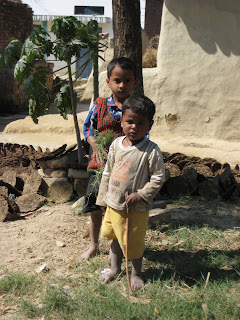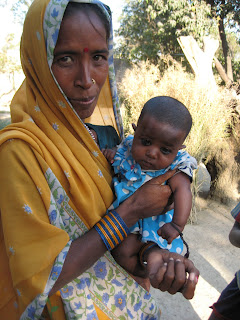

Yesterday's Time of India published finding from a report by the United Nations World Food Programme about hunger in India. This report portrays in facts and figures the reality that we have seen starkly portrayed during our travels. According to the report, 230 million people in India are chronically undernourished and malnutrition accounts for nearly 50% of child deaths in India and 30% of adults have a BMI of less that 18.5. Most of the children we worked with in Sarnath were very small for their ages. Pre-natal malnutrion results in babies who are very tiny and small boned and the r eport says that every second child in India is stunted in growth. Macail would tower over many of the 5 and 6 year olds, and the women are very tiny, their arms so thin that the bangles they wear for marriage do not fit over our large Western hands. More than 70% of children under 5 suffer from anemia, and according to this report, the levels of anemia are actually rising with 11 of the 19 states in India having more than 80% of children with anemia.
eport says that every second child in India is stunted in growth. Macail would tower over many of the 5 and 6 year olds, and the women are very tiny, their arms so thin that the bangles they wear for marriage do not fit over our large Western hands. More than 70% of children under 5 suffer from anemia, and according to this report, the levels of anemia are actually rising with 11 of the 19 states in India having more than 80% of children with anemia. 
 eport says that every second child in India is stunted in growth. Macail would tower over many of the 5 and 6 year olds, and the women are very tiny, their arms so thin that the bangles they wear for marriage do not fit over our large Western hands. More than 70% of children under 5 suffer from anemia, and according to this report, the levels of anemia are actually rising with 11 of the 19 states in India having more than 80% of children with anemia.
eport says that every second child in India is stunted in growth. Macail would tower over many of the 5 and 6 year olds, and the women are very tiny, their arms so thin that the bangles they wear for marriage do not fit over our large Western hands. More than 70% of children under 5 suffer from anemia, and according to this report, the levels of anemia are actually rising with 11 of the 19 states in India having more than 80% of children with anemia. 
As we left Uttar Pradesh and moved in to the Punjab region, the differences between those who can eat and those who do not have enough food became even clearer. Punjab is the bread basket of India, producing nearly 70% of the food supply, and the relative wealth is evident. Many more of the population appear well fed, the men are significantly taller and sturdier than in the other parts of India we have visited and I actually saw my first obese Indian woman yesterday at the temple.
Rising food prices world wide and corruption and inefficiency in the "Targeted Public Distribution System" for food supplies, have, according to the Time "lead to greater food insecurity for large sections of the poor and near poor."



No comments:
Post a Comment